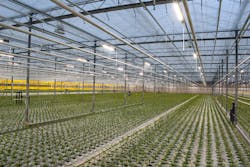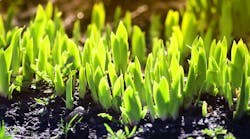Growers who deploy LED lighting rather than conventional high-pressure sodium (HPS) in the greenhouse lower the risk that their plants will succumb to pathogens, because the LEDs provide a more stable heat environment, according to LED lighting vendor Fluence.
Writing on its own blog site, the Austin, Texas–based division of Signify noted: “HPS lights produce a significant amount of heat. However, when they are turned off, the resulting changes in the environment can leave crops more vulnerable to condensation and pathogens as they cool faster than other surfaces. This poses obvious but avoidable risks.
“Under LED lights, the environment is less affected by heat produced from lighting, relying instead on the more precise HVAC system designed exactly for the management of maintaining set points in temperature and humidity,” the blog writers said.
As LEDs Magazine has reported often, heat from HPS can be beneficial, and some growers who install LEDs intentionally mix them with HPS in order to maintain warmer growing temperatures, although the approaches can vary; and sometimes growers indeed use LEDs to moderate heat (see examples in linked story).
But Fluence argued that the hybrid approach ultimately falls short both in lighting and heating performance, and thus heat control should be left to HVAC systems.
“This enhanced stability from LEDs ultimately translates to less condensation on plants, reduced water use, and less dehumidification venting,” Fluence stated.
The company pointed out that HPS-lit greenhouses require venting not only to lower humidity, but also to release excessive heat that can build up.
Keeping the CO2 inside
Venting allows CO2 to escape, which undermines plant growth since the compound is a vital component in photosynthesis, along with water and light. (The purpose of any artificial lighting in the greenhouse is to supplement natural light, as opposed to serving as the primary light source in indoor or vertical farm facilities).
“LED systems decrease the need for venting, which allows for better climate control, CO2 preservation, increased photosynthesis, improved morphology, and lower disease occurrence,” the blog authors claimed.
By relying strictly on HVAC controls and eliminating the heat fluctuations incurred when the HPS lights are switched on, growers facilitate stability that helps plants thrive, Fluence said.
“With HPS systems, it is far more costly and difficult to maintain adequate heat levels, leading to fluctuations that stress plants,” the company wrote. “While HPS lamps may perform two different tasks — both lighting and heating, they accomplish neither task particularly well and represent a far greater danger to plants should they fail. Ultimately, maintaining optimal temperatures should be the responsibility of the HVAC system. An LED retrofit may require the addition of a heating system, but growers will often see reduced heating loads overall and, more importantly, favor their increased control of their environments.”
In one example, LEDs wrote last year that Belgian tomato grower Tomerel reduced its heating bill when it replaced some of its HPS horticultural lighting with LED technology.
Revitalizing the case for horticultural lighting
The latest case against HPS comes at a time when vendors such as Fluence, its sister horticultural division at Signify, and LED chip vendor ams Osram have all reported a slowdown in horticultural business. A big reason is that LED lighting comes with a significant upfront capital cost, which growers seem to be balking at amid current budgetary constraints. And for those considering artificial lighting for the first time, the added electricity bill of even energy-efficient LEDs can be prohibitive.
Hoping that the sales dip is just a blip, vendors like Fluence and Signify are making concerted efforts to overcome growers’ concerns. Signify recently put out the word that minimizing unnecessary white light in favor of other spectra can reduce energy bills.
In its blog, Fluence added another reason for using LEDs instead of HPS illumination: They pose less risk of a fire hazard.
“For those dealing with light pollution regulations and/or using ceiling curtains, LEDs provide the added benefit of lowering the risk of overheating or causing fires, which can translate to reduced insurance premiums,” the company wrote.
The issue of HPS and heat can be a complicated one, and some growers still want the heat of HPS combined with more efficient LEDs so that they gain some energy benefits while holding on to a customary heat source. This is true even among Fluence users, although Fluence now appears to be pushing more against the idea. Dutch tomato propagator Westlandse Plantenkwekerij (WPK), for instance, went with a mix at a new greenhouse two years ago before energy prices shot up. Now, in deference to much higher electricity prices, it switches off the HPS lights before turning off LEDs when the situation calls for dialing down the light levels.
LEDs go vertical
But in the vertical farm sector, operators use LEDs, not HPS, in large measure because hot HPS lights would damage the produce which is grown on racks stacked in close proximity to lights. As mentioned briefly, vertical farms rely exclusively on artificial light. Along with greenhouses, they could be critical to providing global food security. Both potentially expand food output well beyond the normal capabilities of an area’s natural climate, and help place food supplies near end consumers.
Some investors continue to see a strong long-term future for lighting in what’s called controlled environment agriculture. For example, a couple of Canadian firms recently invested CAD $30 million in Montreal-based horticultural LED company Sollum Technologies.
Horticulture is not the only industry where avoiding the heat of conventional lighting can provide climate control advantages. Beer maker Aass Brewery slashed its air conditioning bill when it replaced fluorescent lighting in its storage area with LED luminaires from Glamox.
MARK HALPER is a contributing editor for LEDs Magazine, and an energy, technology, and business journalist ([email protected]).
For up-to-the-minute LED and SSL updates, follow us on Twitter. You’ll find curated content and commentary, as well as information on industry events, webcasts, and surveys on our LinkedIn page and our Facebook page.





